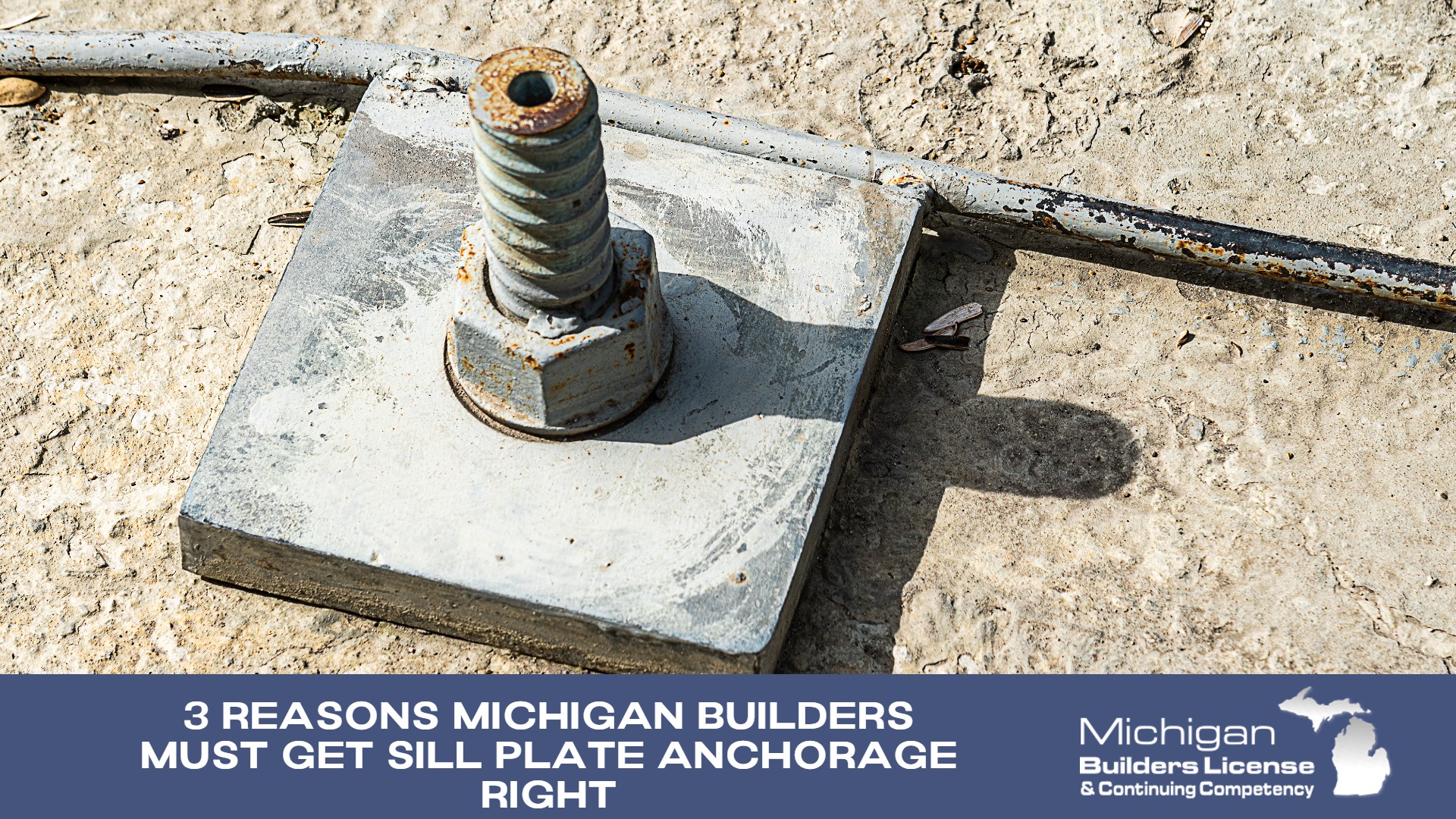When it comes to building safe and code-compliant homes, sill plate anchorage is one of the most important details — and one of the most overlooked. Whether you’re using traditional anchor bolts or modern wraparound straps (mudsill anchors), placement and spacing matter. Mistakes here can weaken the entire structure, expose you to lawsuits, and fail inspection.
Here are the top three reasons to get sill plate anchorage right in Michigan:
1. It’s the First Line of Defense Against Wind Uplift
The sill plate connects the entire structure to the foundation. If it isn’t properly anchored, wind forces can literally push the house off its base. According to the Michigan Residential Code (R403.1.6), wood sill plates must be anchored with ½-inch diameter bolts spaced a maximum of 6 feet on center, with at least two bolts per plate section and bolts located within 12 inches of the plate ends. Each bolt must penetrate at least 7 inches into the concrete or CMU foundation.
The FEMA Home Builder’s Guide to Coastal Construction emphasizes that sill anchorage is a critical part of the continuous load path for resisting uplift and lateral forces during extreme weather. Even in inland regions like Michigan, tornadoes and straight-line winds make proper anchorage essential.
2. Straps Aren’t a Shortcut — They Have Stricter Requirements
Builders sometimes substitute Simpson Strong-Tie® mudsill anchors (MASA/MAB straps) for anchor bolts. These are code-approved alternatives, but they must be installed exactly as shown in the manufacturer’s evaluation reports and instructions.
- Closer spacing required: Unlike bolts at 6' o.c., straps typically require 3'–4' o.c. spacing, depending on species, sill size, and loading conditions. Spacing is not one fixed number—builders must use the prescriptive table in the Simpson product literature.
- Correct installation: Straps are designed to be cast into wet concrete and then wrapped over the sill plate. Retrofitting by bending the strap “ears” into drilled holes is specifically prohibited and voids the product’s rated capacity.
The bottom line: straps only perform as intended when installed per Simpson’s exact specifications.
3. Misplacement Can Lead to Costly Rework and Liability
Anchor bolts are often set in wet concrete before framers arrive, and sometimes they don’t line up with plate joints. Misaligned or missing bolts create delays, require alternative solutions such as post-installed anchors (e.g., Simpson Titen HD®), or risk leaving the sill inadequately secured.
The Insurance Institute for Business & Home Safety (IBHS) has shown in wind tunnel testing that inadequate foundation anchorage is a common weak point in the load path. Walls that aren’t properly tied down can shift or separate under extreme winds—failures that often end in litigation and expensive reconstruction.
Bottom Line
Sill plate anchorage is not a minor detail—it’s one of the most important parts of a home’s structural safety and every Michigan builder’s liability protection.
- Use ½-inch bolts at 6' o.c. and embed them at least 7 inches.
- When using straps, follow the manufacturer’s spacing table (≈3'–4' o.c.) and wrap over the sill as designed.
- Double-check placement before concrete cures, and know your options if corrections are needed.
Correct anchorage can mean the difference between a safe home and a structural failure.
Want a deeper dive into this topic?
Master Instructor Sid Woryn reviews sill plate anchorage, along with other top code issues, in the Michigan Builders License 3-Hour Continuing Competency Course. https://www.michiganbuilderslicense.com/continuingcompetency
You can purchase the course now to fulfill your license renewal requirements.
References & Resources
- Michigan Residential Code (2015) – Section R403.1.6
https://codes.iccsafe.org/codes/michigan - FEMA – Home Builder’s Guide to Coastal Construction, Technical Fact Sheet 1.4: Foundations and Load Paths
https://www.fema.gov/sites/default/files/documents/fema_coastal-construction-manual_2011.pdf - Simpson Strong-Tie® MASA/MAB (Mudsill Anchor) Product Catalog & Installation Guide
https://www.strongtie.com/mudsillanchors_abmasambab_productgroup/wall-stud-to-foundation-connectors - Simpson Strong-Tie® Titen HD® Post-Installed Anchor
https://www.strongtie.com/mechanicalanchors_concreteanchors/titenhdheavy-dutymechanicalanchors/p/titen-hd - Insurance Institute for Business & Home Safety (IBHS) – Fortified Home Standards and Wind Research
https://ibhs.org/fortified/fortified-home/





